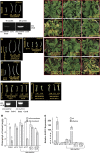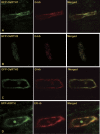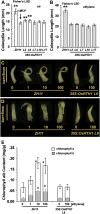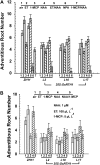Modulation of ethylene responses by OsRTH1 overexpression reveals the biological significance of ethylene in rice seedling growth and development
- PMID: 22451723
- PMCID: PMC3398448
- DOI: 10.1093/jxb/ers098
Modulation of ethylene responses by OsRTH1 overexpression reveals the biological significance of ethylene in rice seedling growth and development
Abstract
Overexpression of Arabidopsis Reversion-To-ethylene Sensitivity1 (RTE1) results in whole-plant ethylene insensitivity dependent on the ethylene receptor gene Ethylene Response1 (ETR1). However, overexpression of the tomato RTE1 homologue Green Ripe (GR) delays fruit ripening but does not confer whole-plant ethylene insensitivity. It was decided to investigate whether aspects of ethylene-induced growth and development of the monocotyledonous model plant rice could be modulated by rice RTE1 homologues (OsRTH genes). Results from a cross-species complementation test in Arabidopsis showed that OsRTH1 overexpression complemented the rte1-2 loss-of-function mutation and conferred whole-plant ethylene insensitivity in an ETR1-dependent manner. In contrast, OsRTH2 and OsRTH3 overexpression did not complement rte1-2 or confer ethylene insensitivity. In rice, OsRTH1 overexpression substantially prevented ethylene-induced alterations in growth and development, including leaf senescence, seedling leaf elongation and development, coleoptile elongation or curvature, and adventitious root development. Results of subcellular localizations of OsRTHs, each fused with the green fluorescent protein, in onion epidermal cells suggested that the three OsRTHs were predominantly localized to the Golgi. OsRTH1 may be an RTE1 orthologue of rice and modulate rice ethylene responses. The possible roles of auxins and gibberellins in the ethylene-induced alterations in growth were evaluated and the biological significance of ethylene in the early stage of rice seedling growth is discussed.
Figures









Similar articles
-
REVERSION-TO-ETHYLENE SENSITIVITY1, a conserved gene that regulates ethylene receptor function in Arabidopsis.Proc Natl Acad Sci U S A. 2006 May 16;103(20):7917-22. doi: 10.1073/pnas.0602239103. Epub 2006 May 8. Proc Natl Acad Sci U S A. 2006. PMID: 16682642 Free PMC article.
-
Association of cytochrome b5 with ETR1 ethylene receptor signaling through RTE1 in Arabidopsis.Plant J. 2014 Feb;77(4):558-67. doi: 10.1111/tpj.12401. Plant J. 2014. PMID: 24635651 Free PMC article.
-
HYPER RECOMBINATION1 of the THO/TREX complex plays a role in controlling transcription of the REVERSION-TO-ETHYLENE SENSITIVITY1 gene in Arabidopsis.PLoS Genet. 2015 Feb 13;11(2):e1004956. doi: 10.1371/journal.pgen.1004956. eCollection 2015 Feb. PLoS Genet. 2015. PMID: 25680185 Free PMC article.
-
Ethylene signaling in rice and Arabidopsis: conserved and diverged aspects.Mol Plant. 2015 Apr;8(4):495-505. doi: 10.1016/j.molp.2015.01.003. Epub 2015 Jan 13. Mol Plant. 2015. PMID: 25732590 Review.
-
Ethylene-mediated regulation of coleoptile elongation in rice seedlings.Plant Cell Environ. 2023 Apr;46(4):1060-1074. doi: 10.1111/pce.14492. Epub 2022 Dec 2. Plant Cell Environ. 2023. PMID: 36397123 Review.
Cited by
-
Ethylene signaling and regulation in plant growth and stress responses.Plant Cell Rep. 2013 Jul;32(7):1099-109. doi: 10.1007/s00299-013-1421-6. Epub 2013 Mar 23. Plant Cell Rep. 2013. PMID: 23525746 Review.
-
Alternative polyadenylation profiles of susceptible and resistant rice (Oryza sativa L.) in response to bacterial leaf blight using RNA-seq.BMC Plant Biol. 2024 Feb 28;24(1):145. doi: 10.1186/s12870-024-04839-6. BMC Plant Biol. 2024. PMID: 38413866 Free PMC article.
-
Rice DB: an Oryza Information Portal linking annotation, subcellular location, function, expression, regulation, and evolutionary information for rice and Arabidopsis.Plant J. 2013 Dec;76(6):1057-73. doi: 10.1111/tpj.12357. Epub 2013 Nov 29. Plant J. 2013. PMID: 24147765 Free PMC article.
-
OsNAC2 Is Involved in Multiple Hormonal Pathways to Mediate Germination of Rice Seeds and Establishment of Seedling.Front Plant Sci. 2021 Jul 23;12:699303. doi: 10.3389/fpls.2021.699303. eCollection 2021. Front Plant Sci. 2021. PMID: 34367219 Free PMC article.
-
Genome-Wide Association Study Reveals Candidate Genes for Root-Related Traits in Rice.Curr Issues Mol Biol. 2022 Sep 21;44(10):4386-4405. doi: 10.3390/cimb44100301. Curr Issues Mol Biol. 2022. PMID: 36286016 Free PMC article.
References
-
- Adams-Phillips L, Barry C, Kannan P, Leclercq J, Bouzayen M, Giovannoni J. Evidence that CTR1-mediated ethylene signal transduction in tomato is encoded by a multigene family whose members display distinct regulatory features. Plant Molecular Biology. 2004;54:387–404. - PubMed
-
- Alonso J, Hirayama T, Roman G, Nourizadeh S, Ecker J. EIN2, a bifunctional transducer of ethylene and stress responses in Arabidopsis. Science. 1999;284:2148–2152. - PubMed
Publication types
MeSH terms
Substances
LinkOut - more resources
Full Text Sources
Molecular Biology Databases

